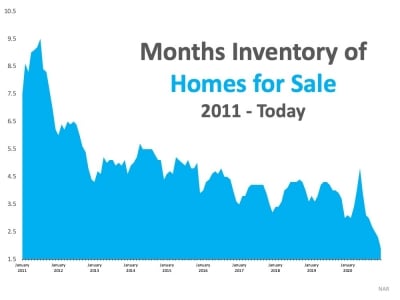The Bay Area real estate market dynamics have been experiencing a significant shift in recent years. A key factor behind this transformation is the historical decline in listings for sale. This unprecedented situation has altered the equilibrium between housing supply and demand, impacting market conditions on a national scale, but also locally here in the Bay Area and Silicon Valley as well. This article will explore the multitude of reasons why the Bay Area has an historic decline in listings for sale.
The Scenario: Dwindling Housing Supply
The landscape of the real estate market is determined by the balance between buyer demand and the supply of houses for sale. In other words, the Bay Area real estate market is very much shaped by the law of supply and demand which dictates pricing for homes. However, since the economic downturn of 2008, a combination of demographic, economic, and market factors have all, to varying degrees, contributed to a drastic decline in housing supply.
The Impact of the Great Recession
The 2008 financial crisis and subsequent housing market crash had a profound impact on the real estate sector. A significant increase in homes available for purchase by homeowners was a key result – there was a huge spike in housing inventory, driven to a large extent by foreclosures. This happened at a time when there was significant job losses throughout the Bay Area, California, and the nation – which greatly affected the demand for housing.
The result was a dramatic crash in home prices. After seesawing back and forth for a time in 2007, home prices dropped like a rock for 18 months starting in 2008 and through 2009. Supply remained at elevated levels relative to demand for another couple of years, before the oversupply was worked through and prices began their rise in 2011. Since about that time, inventory has tightened even as demand has picked up from an ever-resilient Bay Area economy.
The Role of Interest Rates and Rent Increases
The surge in interest rates in 2022 has led to the “mortgage lock-in” effect, deterring homeowners from listing their properties for sale. The reluctance stemmed from the prospect of replacing their low-interest rate mortgages with higher-rate ones. Simultaneously, as rents surged and the tax benefits of owning rental real estate increased (due to tax law changes in 2017), homeowners began to rent out their homes instead of selling them.
A Closer Look at Demographics and Affordability
Demographics also play a crucial role in shaping real estate market trends. Over half of homeowners are now aged 55 and above. As people age, they typically move less often and sell their homes less frequently. This has significantly impacted the supply of listings available for purchase.
Moreover, homes have become more expensive, far outpacing inflation. As a result, the median age of homebuyers has jumped over the past 20 years. Older households, typically being more affluent, are more capable of affording the higher prices.
Impact on First-time Buyers
First-time buyers, who usually trend younger and move more often due to life changes, have been especially hit by the decline in housing affordability. The median age of first-time buyers has also noticeably increased.
The Influence of Population Growth
With the U.S. population increasing by 53.5 million since 2000, the number of people who wish to own homes has also risen. However, the average monthly number of active, existing-home listings during the same period has declined by 45%. This situation, where more buyers compete for fewer listings, leads to overbidding, quicker sales, and higher prices.
Investor Buying and Construction Shortfalls
Since the foreclosure crisis, investors and second-home buyers have made up a significant proportion of sales. This has further intensified demand and competition for listings, particularly in a low-inventory environment.
The lack of new home construction has also contributed to the imbalance. The gap between household formations and new homes built numbers in the multi-millions over the last decade.
The Future Outlook
The balance between supply and demand continues to evolve due to varying economic and demographic conditions. However, since the market recovery in 2012-2013, demand has increasingly outpaced supply.
Even with the rise in interest rates in 2022, which dampened buyer demand, the supply of listings declined as much or more by 2023. This renewed the upward pressure on national and of course Bay Area home prices as well. The historical low in housing inventory is a complex issue, influenced by a multitude of factors. As the market continues to evolve, the real estate sector must adapt to address these challenges effectively and ensure a balanced and thriving market.
The housing market is currently navigating through a challenging phase marked by a stark scarcity of available homes. The phenomenon of low housing inventory has become a significant concern, disrupting the balance between potential buyers and sellers. This article explores the underlying reasons behind this unusual housing shortage and its implications for individuals and the real estate market at large.
Understanding the Concept of Low Housing Inventory
Low housing inventory refers to a situation where the quantity of available homes for sale or rent falls significantly below the demand from potential buyers or renters. This scenario reflects a shortage of housing options in the market and indicates an imbalance between supply and demand. When low inventory prevails, the existing supply of homes cannot match the demand, leading to intensified competition among buyers or renters, escalated prices, and restricted choices.
The Impact of New Construction Delays
Another significant contributor to the low housing inventory is the delay and decline in new construction homes. Builders have been grappling with fluctuating building supply costs and a shortage of skilled tradespeople, leading to a slowdown in new builds. This lack of new construction has resulted in a limited number of homes built and sold each year, thereby exacerbating the scarcity of available housing options.
The Phenomenon of Remote Work and Relocation
The progression of the COVID-19 pandemic saw a shift towards remote work, turning it into a permanent arrangement for many. This change has prompted many families to relocate to more affordable communities with diverse housing options. This influx of remote workers into smaller suburban communities, now dubbed as “Zoom towns”, has led to their own inventory shortages, creating a highly competitive market.
While this should have helped increase inventory in the “core” of the Bay Area, it has exacerbated inventory shortages in areas just a bit further out – like Napa, Sonoma, the Central Valley, Sonoma, Santa Cruz, and Monterey.
The Role of Reluctant Sellers
Potential sellers, aware of the low inventory situation, are choosing to delay their listings until the market stabilizes. The fear of transitioning from a seller to a buyer in a market with limited options has made many homeowners hesitant to sell their homes. Sellers also have the feeling that as interest rates today are much higher than they were a couple of years ago, that buyers will pay less – and if they are able to wait a little longer, rates may drop allowing them to sell at even higher prices. This sentiment has further contributed to the low housing inventory.
The Implications of Low Housing Inventory
The low housing inventory situation presents challenges for both buyers and sellers. For buyers, the limited housing options have resulted in a highly competitive market, marked by bidding wars and skyrocketing home prices. Sellers, while benefiting from a “seller’s market”, face their own set of challenges. The struggle for sellers lies in finding a new home within their preferred timeframe and budget, post the sale of their current property. Ironically, some sellers are actually hoping for a weaker real estate market, with greater supply, as they think it may mean they’ll have an easier time making the purchase of their next home.
Looking Towards the Future
While the current housing shortage may seem alarming, it’s essential to remember that similar situations have occurred in the past. Typically, it takes approximately four to six months to recover the inventory and restore balance to the market. However, the long-term consequences of the COVID-19 pandemic and the historic rise in mortgage interest rates on the housing market are expected to unfold over several years. It may take an extended period before the full extent of the damage caused by the these factors becomes evident, and its impact on the housing market becomes clear.
The Role of Real Estate Professionals
In such a complex and dynamic market, the guidance of experienced real estate professionals becomes crucial. They can provide valuable insights into the latest market trends and help navigate through the challenges posed by the low housing inventory. Whether you’re a buyer or a seller, partnering with a skilled real estate agent can significantly ease your journey in the current housing market.
Concluding Thoughts
The low housing inventory issue is a multifaceted problem rooted in various long-term and short-term factors. While it presents certain challenges, it also opens up opportunities for strategic decision-making and negotiation. By staying informed about the latest market trends and leveraging professional guidance, both buyers and sellers can navigate this intriguing phase of the housing market with confidence and success.
Check out these Great Homes for Multi-Generational Living
2
3
4
5
6
7
8
9
10
11
12
13
14
15
16
17
18
19
20
21
22
23
24
25





